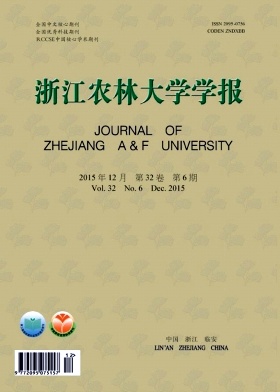| [1] |
XUE Ziqiao, WANG Xuehua, ZHOU Yaqin, CHEN Mengqi, HUANG Qiongtao.
Physical and mechanical properties of low thermo-vacuum treated wood
. Journal of Zhejiang A&F University,
2019, 36(1): 177-182.
doi: 10.11833/j.issn.2095-0756.2019.01.022
|
| [2] |
TANG Cheng, WANG Chunsheng, PANG Shengjiang, JIA Hongyan, ZENG Jie, LEI Yuancai.
Site index table construction for Betula alnoides plantations in the Daqing Mountains, Guangxi
. Journal of Zhejiang A&F University,
2019, 36(4): 828-834.
doi: 10.11833/j.issn.2095-0756.2019.04.024
|
| [3] |
WEI Jinguang, WEI Yanan, BAO Minzhen, ZHANG Yahui, YU Yanglun, LI Changgui, YU Wenji.
Effect of density on porosity and physical-mechanical properties of high-performance scrimbers
. Journal of Zhejiang A&F University,
2018, 35(3): 519-523.
doi: 10.11833/j.issn.2095-0756.2018.03.017
|
| [4] |
ZHOU Zhu, YIN Jianxin, ZHOU Suyin, ZHOU Houkui.
Knot detection on coniferous wood surfaces based on near infrared spectroscopy
. Journal of Zhejiang A&F University,
2017, 34(3): 520-527.
doi: 10.11833/j.issn.2095-0756.2017.03.018
|
| [5] |
FANG Yiming, LIN Lujun, LU Zhixiong, FENG Hailin.
An air-coupled ultrasonic imaging system for non-destructive wood testing
. Journal of Zhejiang A&F University,
2017, 34(2): 355-360.
doi: 10.11833/j.issn.2095-0756.2017.02.021
|
| [6] |
NI Qianqian, QI Hengnian, ZHOU Zhu, WANG Hangjun.
Identifying Dalbergia spp. wood with hyperspectral imaging technology
. Journal of Zhejiang A&F University,
2016, 33(3): 489-494.
doi: 10.11833/j.issn.2095-0756.2016.03.017
|
| [7] |
WANG Zhe, SUN Bailing, LIU Junliang, CHAI Yubo, CAO Jinzhen.
Chemical property changes of vacuum heat-treated Larix kaempferi wood
. Journal of Zhejiang A&F University,
2016, 33(6): 1052-1057.
doi: 10.11833/j.issn.2095-0756.2016.06.018
|
| [8] |
GAO Shan, WANG Lihai, YANG Donghui, XU Wenhao.
Probe-wood contact and gauge pressure with Sylvatest-Duo for precision ultrasonic measurements of wood
. Journal of Zhejiang A&F University,
2016, 33(5): 875-880.
doi: 10.11833/j.issn.2095-0756.2016.05.021
|
| [9] |
MA Zhongqing, ZHANG Qisheng.
Pinus massoniana pyrolysis: influence of temperature on yields and product properties
. Journal of Zhejiang A&F University,
2016, 33(1): 109-115.
doi: 10.11833/j.issn.2095-0756.2016.01.015
|
| [10] |
FANG Lu, WANG Zheng, XIONG Xianqing.
Properties of silane modified poplar veneer/high density polyethylene film composites with varying pressing temperatures
. Journal of Zhejiang A&F University,
2016, 33(3): 483-488.
doi: 10.11833/j.issn.2095-0756.2016.03.016
|
| [11] |
LUO Jingyi, FU Weirui, PAN Chengyuan.
Identification of wood-rotting fungi and their decay capability in six wood species
. Journal of Zhejiang A&F University,
2015, 32(1): 1-10.
doi: 10.11833/j.issn.2095-0756.2015.01.001
|
| [12] |
ZHANG Lei, CHANG Xiaoya, WU Jing, WANG Mingzhi.
Fire-retardant properties of an intumescent fire retardant coating for wood using 4A zeolite
. Journal of Zhejiang A&F University,
2015, 32(1): 156-161.
doi: 10.11833/j.issn.2095-0756.2015.01.023
|
| [13] |
ZHANG Weigang, BAO Binfu, DU Chungui, ZHANG Hong.
Combustion properties of Chinese fir densified by phenolic resin impregnation and compression
. Journal of Zhejiang A&F University,
2015, 32(3): 399-403.
doi: 10.11833/j.issn.2095-0756.2015.03.010
|
| [14] |
ZHOU Zhu, FANG Yiming, YIN Jianxin, ZHOU Suyin, LUO Ruisen, ZHENG Jian.
Review of nondestructive detection of wood and wood products based on hyperspectral imaging technology
. Journal of Zhejiang A&F University,
2015, 32(3): 458-466.
doi: 10.11833/j.issn.2095-0756.2015.03.020
|
| [15] |
HUANG Mengxue, ZHANG Wenbiao, ZHANG Xiaochun, YU Wenjun, LI Wenzhu, LIU Xianmiao, DAI Chunping, WANG Sunguo.
Factors for Phyllostachys edulis timber glass transition temperatures
. Journal of Zhejiang A&F University,
2015, 32(6): 897-902.
doi: 10.11833/j.issn.2095-0756.2015.06.011
|
| [16] |
LI Xiaoping, WU Zhangkang, WANG Jun.
Manufacture and properties of Pinus kesiya flame retardant plywood
. Journal of Zhejiang A&F University,
2013, 30(5): 724-728.
doi: 10.11833/j.issn.2095-0756.2013.05.014
|
| [17] |
YAN Zheng-liang, LIU Yun-cai, HU Guang-hui, LIU Yong-gang, MENG Meng.
Primary insect pest occurrence and tree diversity in stands of Pinus kesiya var. langbianensis
. Journal of Zhejiang A&F University,
2012, 29(2): 226-231.
doi: 10.11833/j.issn.2095-0756.2012.02.012
|
| [18] |
LI Si-guang, FU Yu-pin, ZHANG Kuai-fu, JIANG Yun-dong, YAO Zhi-qiong, LI Ming.
Half-sib progeny tests of high-resin-yielding Pinus kesiya var. langbianensis
. Journal of Zhejiang A&F University,
2008, 25(2): 158-162.
|
| [19] |
YANG Bin, ZHAO Wen-shu, JIANG Yuan-biao, WANG Fa-zhong.
Seedling selection and fertilization effect of Pinus kesiya var .langbianensis plantation
. Journal of Zhejiang A&F University,
2005, 22(4): 396-399.
|
| [20] |
CHEN Qiang, ZHOU Yue-hua, CHANG En-fu, LI Pin-rong, BI Bo, ZHAO Yong-hong, GUAN Jin-shu.
Selection of superior trees of Betula alnoides
. Journal of Zhejiang A&F University,
2005, 22(3): 291-295.
|






 DownLoad:
DownLoad: